![]()
![]()
![]()
Use LEFT and RIGHT arrow keys to navigate between flashcards;
Use UP and DOWN arrow keys to flip the card;
H to show hint;
A reads text to speech;
96 Cards in this Set
- Front
- Back
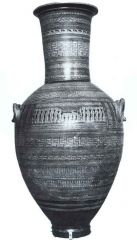
|
Dipylon Amphora
Late Geometric style Terra cotta 750 bce Dipylon Cemetery, Athens •Amphora: carried from both sides •Most famous geometric art piece, important to Greek cultural identity •Not just decorative, marked a tomb (monumental) Central scene: funeral, dark against light, conventional type •Patterning suggestive of weaving, "meander" pattern •Not strictly geometric, has a central scene, from middle part of Geometric period |
|
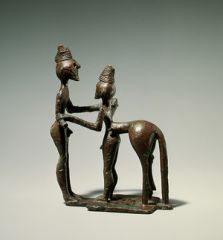
|
Man and Centaur
Late geometric style solid-cast bronze 750 bce (Olympia) •Votive sculpture: voluntary offering for a god •Figures reveal themselves very much as silhouettes, reads well from side angle •A struggle is occuring but artist hasn't dramatized it very well, dramatic action piece (in Greek art, the figure is always engaged) |
|
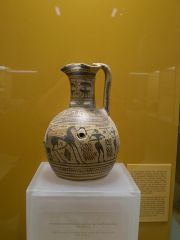
|
Late Geometric jug
late Geometric style terra cotta 700 bce (Athens) •To compare with "Diplyon Amphora:" narrative interest beginning to outweigh the decorative interest (meander and ornaments are still there, thought) •Documents period of Greek history: shift from valuing heroic, individual warfare to groups of foot armed soldiers |
|
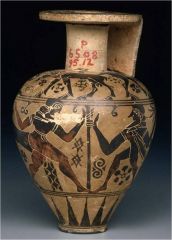
|
The Ajax Painter
(Aryballos with scene of Herakles or Zeus struggling with centaur) 680 bce ceramic Middle proto-Corinthian style (regional) & Orientalizing (numerical) •Proto-Corinthian: early phase of Corinthian period. (Use of outline along figures masde by incision with blunt tool adds white color and more interior details) •Increasing interest in story and dramatic action •Shifting more towards Orientalizing period (motifs from Assyrian art) |
|
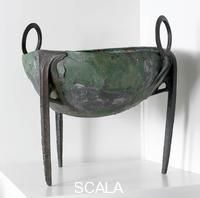
|
Bronze Tripod Cauldron
Orientalizing 8th century bce bronze (Olympia) • Useful for camping on uneven ground • Rings designed to insert pole through for carrying • Less decorated than many of the time |
|
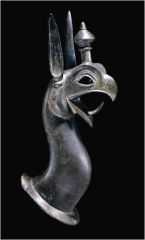
|
Griffin-head protome (from a bronze tripod cauldron)
Orientalizing cast bronze 650 bce (Kameiros, Rhodes) •Protome: frontal view of an animal head, extending outwards • attaches to handle of a cauldron • very figural, detailed, more ambitious, intro to Orientalization • very animated |
|
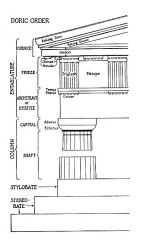
|
Doric Order (1 of 3 Greek types of columns)
|
|
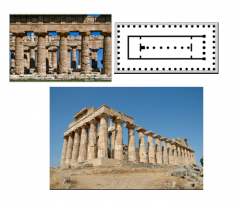
|
Temple of Hera I
6th century bce Doric Style, Archaic (Paestum) • Doric Temple of Archaic Period, 9 (odd number- unusual) columns in facade •structure looks clunky and heavy. Later, columns became slimmer as Greeks became mroe confident is being able to support horizontal beams • sides of columns curve • Meant to be seen in the round at all angles (unlike Romans, organically whole) • Greeks trusted what they saw rather than using strict mathemaical formulas for art (unlike Egypt) • Introduced notion of optical refinements: concessions of the eye, mostly in regards to proportion • bottom: groundplan of Hera temple • Doric Order |
|
|
The 3 Delphic Maxims
|
Carved into temple of Apollo at Delphi
• Know thyself • Nothing in excess • Make a pledge and ruin is nigh |
|

|
Kore (maiden)
Orientalizing, Didactic style Limestone 630 bce • Egyptian aspects, especially square block underneath her, but does not have a back pillar • belt somewhat in continuity with Aegean motifs, geometric patterning on clothing as well • Modestly dressed but we can still see her figure |
|
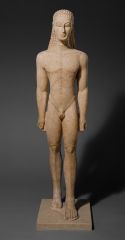
|
Kouros (male youth)
Didactic style, Archaic Marble 600-590 bce • Some Egyptian aspects, but is not holding anything in clenched hand and is balancing on his own weight without a back pillar (thick ankles to support legs and long hair to support neck) • forms within torso almost look carved in relief, aren't really sculpted or fully 3-D, relationship between surface and depth/mass is shallow • pose: standing, may also be walking (like Egypt) |
|
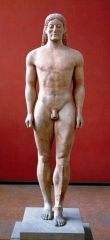
|
Kroisos (Kouros from Anavysos)
Archaic style Marble 540-525 bce • Progress in every way from earlier Kouros, especially with relationship between surface and mass. Mass emerges much more convincingly and actually looks sculpted • Has ornate hair like original Kouros |
|

|
Peplos Kore
Archaic style Marble 530 bce (Athens) • Peplos: tight woolen garment worn by Greek women, turns figure into cylinder, she is also wearing a chyton undergarment • Smiling (unlike Egypt) is prevalent in Greek art • "Archaic smile:" looks silly and almost painted on due to struggle betwen surface and mass • life resides in eyes, pupils (and hair) still have remnants of paint • Part of the "Persian Debris," was protected from oxygen and weathering underground |
|

|
Kore, from Chois (?)
Marble Archaic style, Ionic Marble 520 bce • Costume is recognized as eastern Greek (Ionic, not Doric), wearing a chyton and a sash with folds • she is meant to be pulling up her skirt, Greek sculpture always incorporating action • Archaic smile: looks good in profile and straight on, but at 3/4 view, it literally looks like a mask is being worn |
|

|
Siphnian Treasury
525 bce Archaic style (Delphi) • A small temple/bank • Kore figures are surrogates for columns, anthropormorphism is very prevalent throughout Greek art • Women statues thought to be in servitude, having to hold up the building themselves, (this was a warrior culture and did not consider labor to be a sacred act, valued war and politics instead). |
|
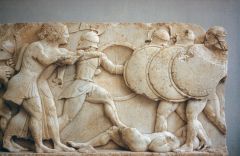
|
Battle of the Gods and Giants ("Gigantomachy")
from north frieze of Siphnian Treasury Marble Archaic style 525 bce • Higher relief than we're used to • Use of layering/overlapping figures was ambitious, conveys much action among figures • Left: Artemis and Apollo attacking Giants • Giants identified by inscriptions on their shields (introduction to writing), and were put in contemporary armor to resemble foot soldiers |
|
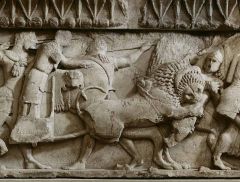
|
Battle of the Gods and Giants ("Gigantomachy")
from north frieze of Siphnian Treasury Marble Archaic style 525 bce • Shows Herakles and lions leading a chariot attacking the giants |
|

|
Aphaia Temple
500-490 bce Late Archaic style, beginnings of Classical style (Aegina) • Aegina is an island, Aphaia was their goddess equivalent to Athena • Temple: beginnings of severe style/early classical: columns are slimmer and farther apart • Ionic Order |
|

|
Dying Warrior
Marble Late Archaic style 500-490 bce (Aegina, west pediment of Aphaia Temple) • A Kouros type adapted to the context of battle, not done very well, not a convincing figure |
|
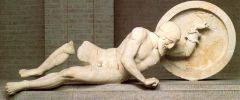
|
Dying Warrior
Marble Early Classical style 480 bce (Aegina, east pediment of Aphaia Temple) • Thought to be made later in date than dying warrior on west pediment, it is more advanced and believable • Hips are twisted, rib cage appears more weighted • He is bearing his teeth => about to die |
|
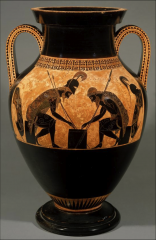
|
Exekias
Achilles and Ajax Playing Dice Attic black-figure amphora 540-530 bce Archaic style • Attic clack figure: specific style and medium • Figures are labeled, use of text is prevalent throughout the piece • Bilaterally symmetrical • Black figure technique: figures are shown in black Silhouette (like Geometric period: dark on light) • Shape of vase is very refined and anthropomorphic (base=foot, body=belly, handles=arms, also bows out like a column) • Heroes have interior detail (done by incision) that is mostly ornamental, although does show a little indication of muscle • Archaic: surface is not completely mitigated with mass. |
|
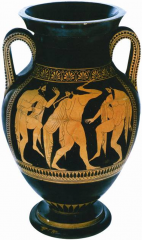
|
Euthymides
Dancing Revelers Attic red-figure amphora 510-500 bce Late Archaic style • Light on dark, unlike attic black-figure. Reversal of value lets artist paint internal detail in different way (extrusion) • Frame acts as a window, rather than a need for a panel like attic black-figure • Little depth in figures, common in Greek art. They focus on what figure is doing • Figures taking off from just profile, twisting and balancing |
|
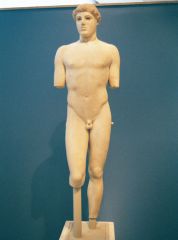
|
Kritios Boy
Marble 480 bce Early Classical style (Acropolis) • Marble is intermediate material in regards to hardness • May be part of "Persian Debris," not sure • Transitioning between Archaic and Classical • Contrapposto stance (action in repose). Figure is self-supporting, arranges weight in a lively way, a momentary pause. 1 leg tense, the other relaxed. • Archaic smile is gone |
|
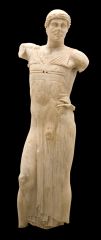
|
Charioteer from Motya
Marble 450-440 bce Classical style • Early classical: slightly awkward • The first is in exaggerated contrapposto, raised left arm |
|
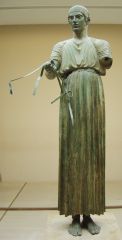
|
Charioteer from Delphi
Bronze 478 bce Classical style • Early classical: slightly awkward |
|
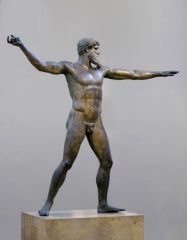
|
Poseidon (Zeus?)
Bronze 460-450 bce Classical style (Cape Artemision, 6'10") • 450 bce on is considered High Classical • Weapon he would have been hurling is not preserved, could have been a trident or lightning bolt • Incredible detail in face • Conforms to same plane, looks like pentagon • Bronze has greater tensile strength than marble, allowed artist to use ankles as support and arms can be outstretched |
|

|
Riace Warrior 'A'
Bronze 450 bce Classical style • Found in the sea • Contrapposto • Upper torso turns to balance over relaxed leg, limbs show opposites • Probably a public monument • Beginnings of High Classical, has earmarks of Early Classical (wide shoulders, slim hips) • No tension between surface and mass |
|
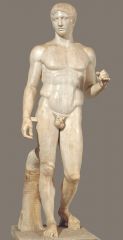
|
Polykleitos
Doryphoros (Spear Bearer) 450-440 bce High Classical style Original: bronze (copy: marble) • Epitome of classical style, considered the peak • Was called the "cannon" in antiquity because Polykleitos was an expert at proportions, he believed harmony could be expressed mathematically • Greek cannon based on harmonic proportions and joints • This was a copy even in antiquity • From Pompeii • contrapposto • replica series: work known through a series of replicas • "Doryphoros" vs. "Warrior 'A'" • Proportions are a bit different • Doryphoros is less flat-footed, more solid in the way he stands • Warrior A looks more boyish because hips-shoulders ratio isn't exactly 1:1 (Archaic style) |
|
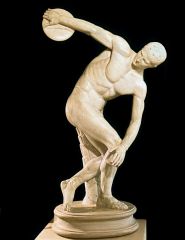
|
Myron
Diskobolos (Discus-Thrower) 450 bce Classical period Original in bronze, marble copy from Roman era • Similar to Poseidon in that it has abstract geometry, forms a triangle with head at apex (mind working with the body) • Ideal athletic statues were erected to heroize winners of the Olympics, godlike status |
|

|
East & West pediments of Temple of Zeus
460 bce Classical style (Olympia) • West pediment: violent, war between Greeks and centaurs (Battle of Lapith, conflict between order and chaos), Apollo overlooking all, God of reason • East pediment: Zeus overlooking all, story of Pilops & Inomaz (?) |
|
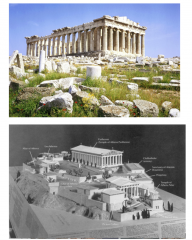
|
Iktinos & Kallikrates, architects
The Parthenon 447-432 bce Classical style white marble Athens • Dominant temple of Akropolis, esp. with cult of Athena • Doric outside & variation of Ionic inside, 8x17 columns • Slender columns, capitals smaller/ less flaring, wider spaced columns, load they're carrying seems smaller, columns seem t be able to carry it then with ease • perfection of Greek architecture • steps curve, many small irregularities like that give dynamic quality • Temples at this time used more as a bank, to protect objects made for the gods • Model of Acropolis: originally used for government, then became more for religious purposes, principal center of Athenian public life • Perikles intended buildings to act as programmatic unit |
|
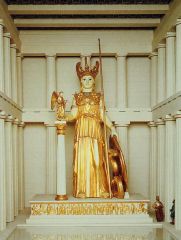
|
Pheidias, artist
Cult statue of Athena 447-432 bce Classical style Original made of gold, ivory (from the Parthenon, Athena) |
|

|
Reconstruction drawing of East Pediment of the Parthenon
447-432 bce Classical style Marble • Represents birth of Athena • dramatic action • architectural, freestanding sculpture • Increasing level of energy as we reach center |
|

|
Dionysos (Herakles?)
from East Pediment of Parthenon Marble 438-432 bce Classical Style • Iconography is a mystery, we're not sure who is being depicted |
|
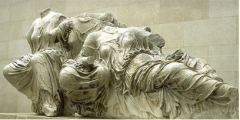
|
Three goddesses
from East Pediment of Parthenon 438-432 bce Classical Style Marble • tectonic posture: fit into frame of pediment, sloping pediment • iconography a mystery, could be Aphrodite and mother • represents ripe classical style, more sensuous than mathematical • "wet drapery form" : wet t-shirt contest on ideal body • this type of drapery reveals and accentuates form rather than hiding it |
|
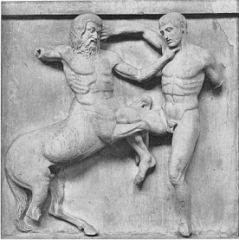
|
Centaur & Lapith
Metope from south frieze of Parthenon Marble 438-432 bce Classical style • Made earlier in date for Parthenon • Some metopes from first stage look awkward, they had to train sculptors as they built the Parthenon • not great |
|

|
Detail of west frieze of Parthenon
443-482 bce Classical style Marble • overlapping figures, frenzied animals representing a festival to honor Athena, idealized event • Depicts mortals in a space where mythological beings have always been |
|

|
Knights from west frieze of Parthenon, detail of horse from west frieze
Marble 438-432 bce Classical Style • Greeks had begun to domesticate horses • Knights- military virtue, high in society • horse detail is beautiful, almost seems like the subject |
|
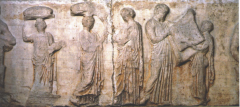
|
Folding of the Peplos
east frieze of Parthenon 440 bce Classical style marble • presentation of new piece of clothing to old Athena • controversy as to whether it is depicting a myth or reality, if myth its iconography is integrated Athenians and divine space => self-confidence • "Parthenon/ Pheidian style" : artistic, philosophical ideal; idealized Athenians (proportion, faces) elevate them from uncivilized world |
|
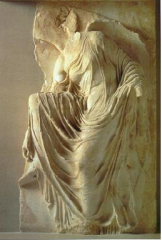
|
Nike Adjusting her Sandal
410-407 bce Classical Marble • from balustrade of Athena Nike Temple, Acropolis • wet drapery style, standard • identifiable to be Nike clearly, has wings • sensuous • Pheidian style in drapery |
|
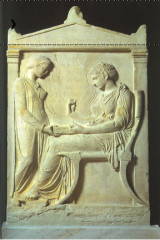
|
Grave of Hegeso
Marble 410-400 bce Classical style • tombstone once public projects ended, sculptors needed an outlet, and individual displays of wealth became permitted • stele- standing stone • given border so looks like mini temple, depicts Hegeso in afterlife with servant, servant is handing her a necklace that is slightly off-axis so energizes composition • tectonic: figures correspond to frame • closed form • wet drapery style • very end of ripe Classical period • Pheidian style in drapery, idealized faces, and quiet mood |
|
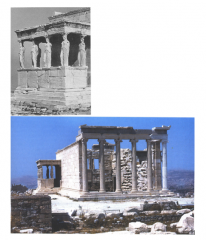
|
2 views of the Erechtheion (2nd: South porch of the Maidens)
421-405 bce Classical style (Acropolis, Athens) • ionic order • irregular plan- 4 rooms, basement, 2 porches • Dealt with Athena & Poseidon battling for custody of Akropolis, includes saltwater pool for Poseidon and olive tree Athena gave |
|
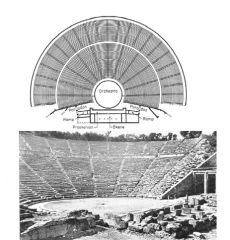
1 cavea
2 orchestra 3 cunei |
Theater at Epidauros
Early 3rd-2nd centuries bce Hellenistic style • theatre/ drama used like public festival, dancing • based around circular floor • evolved from hillside seating • theatre in the round • cavea: seating area orchestra: level area for performance cunei: seats grouped in wedge-like sections • you can still hear slightest whisper in cavea |
|
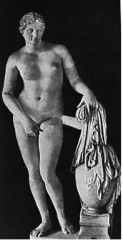
|
Praxiteles
Aphrodite of Knidos (copy) Marble 340-330 bce Late Classical Style • Shift from political/civic art to personalized/individual art • emerging from a bath, not coy or embarrassed by nakedness • Large scale makes it more scandelous • People of Kos rejected the statue in favor of a draped one, but Kindos accepted it, and she became a huge tourist attraction • 1st Greek nude statue of a goddess • viewer's role more complex: the sculpture invited physical & emotional engagement, not just respect |
|
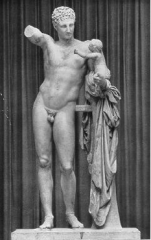
|
Praxiteles
Hermes with Infant Dionysos Marble 320-310 bce Late Classical Style • "Praxitilean contropposto" - additional element of tree & drapery which he is resting his elbow on comes into play • "S curve" from hip • You no longer see the work as distinct parts, but as a whole, and individual features aren't sharp, but melt together • Teasing Dionysos with grapes, carrying him away to protect him from Hera • Most believe it to be a copy due to strut support, but is extremely high quality |
|

|
Lysippos
"Apoxyomenos" 330 bce Late Classical style Marble • Genre type rather than depicting specific person • An athlete, may have decorated a gym • artist known for reducing proportion of head to body, so body is emphasized • he is reaching out into the viewer's space, feels shocking, calls for more than just a frontal view • scraping oil off of arm • fig leaf not part of original |
|
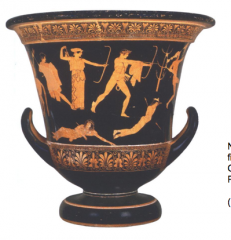
|
Niobid painter.
Red-figure calyx krater 460-450 bce Classical Style • Copious style figures in landscape, complex • Each figure has own groundline, suggesting rocky terrain • Apollo & Artemis killing Niobe's sons/daughters • Figures do not recede in depth, Greeks were less interested in perspective |
|
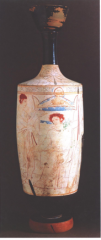
|
Reed painter
White-ground lekythos. 425-400 bce Classical style • jar used for ointments • new painting styles, beautiful free brush strokes • "fugitive" colors (added after finishing) • Brooding hero sits on own tombstone, emotion is captured |
|
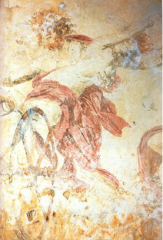
|
Abduction of Persephone, detail of wall painting in Tomb 1
340-330 bce Late Classical style, Earliy-ish Hellenistic • Pluto kidnapping Persephone • progression of wall painting: shading (chiaroscuro, "skiagraphia") • perspective view of chariot wheel (ellipse, not circle) • very active |
|
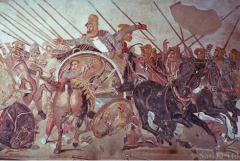
|
Alexander Mosaic
100 bce (?) after original of 317 bce (?) Hellenistic style Pompeii • floor mosaic, up to 2 million pieces of stone • Alexander the Great & Greeks fighting Darius III & Persians at Issos, Persians seem to be fleeing and getting away • limited palette, "reddish" tint, of yellow, black, red & white, but up to 90 different shades • foreshortened forms and minimal landscape (single barren tree) help us place it in history |
|
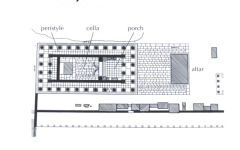
|
Priene, Temple of Athena
Pytheos (Architect) 334 bce Late Classical style, early Hellenistic • Pythios wrote books about his art • Ionic Eustyle, 6x11 columns • uniform spacing of columns, can analyze the plan with a grid, more mathematical than past temples • no deviations from the rule, no refinements • architectural theatricality: scholarly tradition, as Athens declined Greeks thought of themselves more as individuals than as members of city-state, architecture catered more to personal xp, tried to incite meaningful revelation |
|
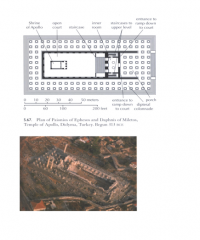
|
Plan of Paionios of Ephesos & Dashnis of Miletos
Temple of Apollo Begun 313 bce Hellenistic Style • Ionic • use of marble in architecture - fancy • defied expectations upon entering, intricate, manipulated visitors along unexpected paths • TWO rows of columns instead of just one • Huge temple • Forest of columns, labyrinth, was like Greek version of hypostyle wall • architectural theatricality • light diagrams of temple's design on wall • incomplete |
|
|
krater
|
Greek vessel, of assorted shapes, in which wine & water are mixed. Often used as burial markers
|
|
|
meander
|
Type of pattern seen on Greek vessels, decorative motif of intricate, rectilinear pattern (part of Geometric period)
|
|
|
frieze
|
Continuous band of painted or sculpted decoration, often below a pediment
|
|
|
aryballos
|
small perfume jar, minutely decorated
|
|
|
guilloche pattern
|
repeating pattern, 2 ribbons spiraling around a series of points
|
|
|
iconography
|
study of art by subject matter
|
|
|
closed form
|
Action stays within plane of relief
|
|
|
protome
|
decorative, protruding attachment, often seen on bronze tripod cauldrons.
|
|
|
polis
|
city-state, developed in 600 & 500's bce in Greece, during Orientalizing & Archaic period
|
|
|
naos
|
cella, principle enclosed room of a temple to house a god's image
|
|
|
pronaos
|
open porch in front of cella/naos
|
|
|
peripteral temple
|
when a peristyle (colonnade, or row of columns supporting a roof) surrounds the cella/naos. Generally 6-8x12-17 columns, offers shelter from the elements for worshippers, transitional zone from outdoors to indoors
|
|
|
enneastyle
|
9 columns across front & rear (Temple of Hera I)
|
|
|
hexastyle
|
6 columns across front and rear (Temple of Hera II)
|
|
|
entasis
|
swelling effect of columns, strong w with Temple of Hera I
|
|
|
Archaic smile
|
Fixed, unnaturalistic smile. May look almost painted on, fake, a mask
|
|
|
chiton
|
rectangular fabric draped and fastened at the shoulder by pins, seen on kore sculptures
|
|
|
synoptic narrative
|
Fusing 2 separate moments from a single story, often done in pediments of temples
|
|
|
acroteria
|
free-standing figures affixed above pediment, on the corners and in the center
|
|
|
caryatid
|
female statue in place of columns
|
|
|
allegory
|
figures or events stand for ideas beyond themselves as symbols or metaphors, frequent strategy in Greek art
|
|
|
black-figured technique
|
Technique for painting vases during Archaic period, figures were in black silhouette against reddish clay, with internal details using needle, then white and purple painted over the black, highly decorative, detail is limited to incision
|
|
|
red-figured
|
Technique for painting cases during Archaic period, opposite of black-figured and replaced it. Light on dark, scene is less dependent on profiles, can depict greater range of poses
|
|
|
contrapposto
|
In sculpture: one engaged leg, one leg at ease and bent slightly. Relaxed pose, but still conveys motion
|
|
|
metope
|
square space between 2 triglyphs in a Doric frieze
|
|
|
pediment
|
triangular section above entablature of a temple, supported by columns
|
|
|
white-ground
|
Type of vase painting in Classical era, similar to wall painting, reserved for vases deposited with burials, lots of colors painted onto white slip background, favored a lekythos to paint on (type of oil flask for funerals)
|
|
|
baroque
|
extreme emotions, extravagant gestures, theatrical locations (Nike of Samothrace), lighthearted and faintly erotic, often used to describe Hellenistic era.
|
|
|
shading, aka skiagraphia
|
modulation of volume by means of contrasting light and shade, aka skiagraphia
|
|
|
spatial perspective
|
rendering recession of space, fascination of illusionism emerged during Hellenistic era
|
|
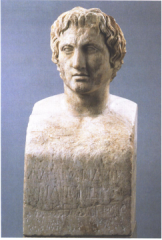
|
Lysippos
Portrait of Alexander the Great, the "Azara Hern" Marble Late 4th century bce Hellenistic era • Reduced head on herm (portrait herm) • Roman copy • very slight expression |
|
|
herm
|
comes from "Hermes" (god of travelers), sculpture with a head above a plain, ideal for an inscrtiption
|
|
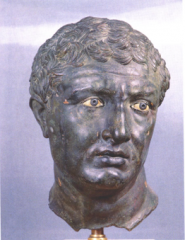
|
Portrait Head
Delos 80 bce Hellenistic era bronze • heavy, worried expression shows world-weariness, looking for salvation • pathos style (as opposed to ethos style) |
|
|
pathos (vs. ethos)
|
• Pathos style emerged in Hellenistic era particularly in sculpture, characterized by world-weariness, worried, heavy, looking for salvation.
• This was around the time that the polus was falling apart as world empires took over. • Suggests advancement of the human spirit, adds greater complexity to art than Ethos (expressionless, represents the perfect human being, both ethically and physically) |
|
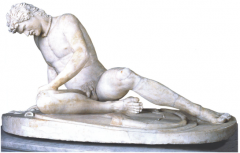
|
Epigonos of Pergamon
Dying Trumpeter Marble, maybe Roman copy after bronze original 230-220 bce Hellenistic era • Mortally wounded Gaulian, foreign type (bushy hair, mustache, necklace), probably killed himself to escape slavery after losing war • Celebrates nobility of Gaul, as well as Pergamon's • historical - actually happened • Though a foreigner, he is dying nobly. Shows interest in different characters, world is bigger than the old Greek world |
|
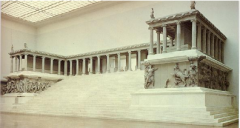
|
West Front of Great Altar of Zeus at Pergamon
166-156 bce Hellenistic era • stepped altar, originally a square foundation with open middle space holding an altar |
|
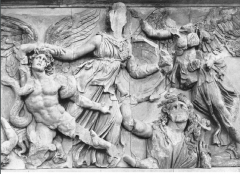
|
Detail of frieze of West Front of Altar of Zeus at Pergamon
166-156 bce Hellenistic era • Mythological subject, depicting Battle of the Gods & Giants and the Greek victory • Not classical, but very troubling. Depicts snakes and wings entangled, almost like animal combat, worried expressions • Hellenistic baroque • high relief, almost free-standing |
|
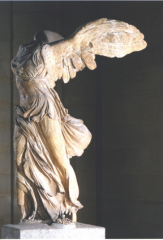
|
Pythokritos of Rhodes
Nike of Samothrace 190 bc0 Hellenistic era Marble • head has never been found • Nike shown landing on prow of ship, fluttering to retain balance • celebrated some victory in Hellenistic period • Pergamonian, Baroque style • drapery doesn't behave itself like in classical era, but is struggling and flapping around, and through this we can feel the wind she's feeling, and get a sense of the environment she is in. • in Hellenistic era, the figure was no longer self-contained, but existed in a context (ie wind) |
|

|
3 Rhodian sculptors
"Lacoon and His Sons" early 1st century Hellenistic era marble • episode of Homeric cycle, Trojan priest and his sons are being strangled by sea serpants • One of the first people to die for Rome, so dies on an altar, almost like a sacrifice |
|
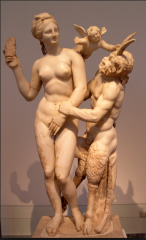
|
Aphrodite, Pan, & Eros
100 bce Hellenistic era marble • Aphrodite uses slipper to fend off Pan, the half-man/half-goat god of the forests, Eros hovers between them mischievously • Greek original found in location where it stood in antiquity |
|
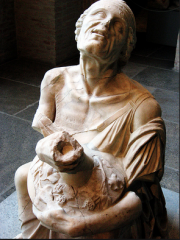
|
Drunken Old Woman
Marble, Roman copy Late 3rd or 2nd century bce Hellenistic era • depicts unidealized, realistic life in genre known as Hellenistic Realism • old woman crouched, head thrown back, grasping at wine bottle, wrinkled, sagging skin on exposed shoulder • of affluent social class based on clothing • is the artist offering s sympathetic or critical view? |
|
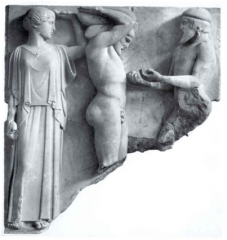
|
Atlas Bringing Herakles the Apples of the Hesperides
460 bce Marble Classical Metope from east side of Temple of Zeus • Shows labors of Herakles holding globe to exchange with Atlas who has the apples, Athena helping from behind • High relief |
|

|
Maiden & Centaur Fighting, from Battle of Lapiths & Centaurs from west pediment of Temple of Zeus
460 bce Classical marble Olympia • We know she'll win because she remains beautiful & calm and he look disfigured |
|
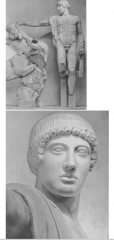
|
Apollo from Battle of Lapiths & Centaurs of west pediment of Temple of Zeus
460 bce Classical Olympia • Head looks more Archaic than Classical • No tension with surface & mass • Overlooking the battle, center of pediment |

